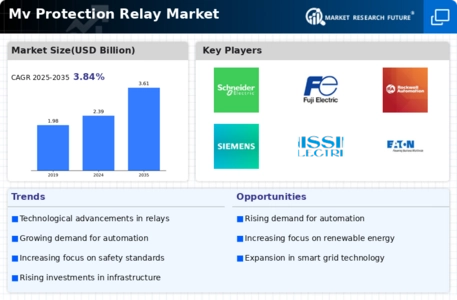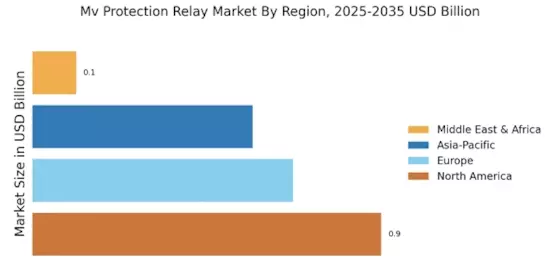Growing Industrial Automation
The Mv Protection Relay Market is significantly impacted by the growing trend of industrial automation. As industries increasingly adopt automated systems to enhance productivity and efficiency, the need for reliable protection mechanisms becomes more pronounced. Mv protection relays are essential in safeguarding automated electrical systems from faults and ensuring operational continuity. The market is projected to witness a growth rate of approximately 5% annually, driven by the rising adoption of automation technologies across sectors such as manufacturing, oil and gas, and transportation. This trend indicates a robust opportunity for stakeholders in the Mv Protection Relay Market to innovate and develop advanced protection solutions that cater to the evolving needs of automated environments.
Integration of Smart Grid Technologies
The integration of smart grid technologies is significantly influencing the Mv Protection Relay Market. As utilities and energy providers adopt advanced technologies to enhance grid efficiency, the demand for sophisticated protection relays is expected to rise. Smart grids facilitate real-time monitoring and control of electrical systems, which necessitates the use of advanced Mv protection relays that can communicate and respond to system changes dynamically. This shift towards smart grid solutions is anticipated to drive the Mv Protection Relay Market, with estimates suggesting a market growth of around 7% annually as utilities invest in modernizing their infrastructure. The ability of Mv protection relays to integrate with smart technologies positions them as essential components in the evolving energy landscape.
Rising Investments in Renewable Energy
The Mv Protection Relay Market is poised for growth due to rising investments in renewable energy sources. As countries strive to meet sustainability goals and reduce carbon emissions, there is a marked increase in the deployment of renewable energy projects such as wind and solar farms. These projects require robust protection systems to ensure operational safety and efficiency, thereby driving the demand for Mv protection relays. Recent reports indicate that investments in renewable energy are expected to exceed USD 1 trillion annually by 2025, creating a substantial market for protective devices. The Mv Protection Relay Market stands to benefit from this trend, as these relays are critical in safeguarding renewable energy installations from faults and ensuring their reliable operation.
Emphasis on Safety and Compliance Standards
The Mv Protection Relay Market is increasingly shaped by the emphasis on safety and compliance standards. Regulatory bodies are implementing stringent safety regulations to protect personnel and equipment in electrical installations. This regulatory environment compels industries to invest in advanced protection systems, including Mv protection relays, to ensure compliance with safety standards. The market is expected to grow at a rate of around 4% annually as companies prioritize safety and risk management in their operations. This trend highlights the critical role of Mv protection relays in meeting regulatory requirements and enhancing the overall safety of electrical systems, thereby presenting opportunities for manufacturers to develop compliant and innovative solutions.
Increasing Demand for Reliable Power Supply
The Mv Protection Relay Market is experiencing a surge in demand for reliable power supply solutions. As industries and urban areas expand, the need for uninterrupted power becomes paramount. This demand is driven by the increasing reliance on electrical systems for critical operations across various sectors, including manufacturing, healthcare, and data centers. The Mv Protection Relay Market plays a crucial role in ensuring the stability and reliability of power systems, thereby preventing outages and equipment damage. According to recent data, the market is projected to grow at a compound annual growth rate of approximately 6% over the next five years, reflecting the heightened focus on maintaining power quality and reliability. This trend indicates a robust opportunity for manufacturers and suppliers within the Mv Protection Relay Market.


















Leave a Comment